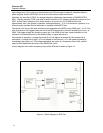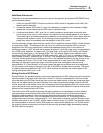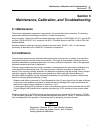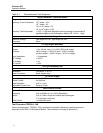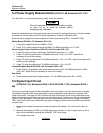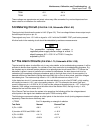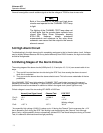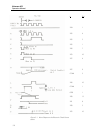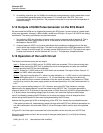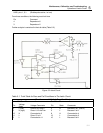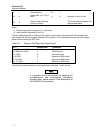
Maintenance, Calibration, and Troubleshooting
Signal Input Circuit
5
5-5
TP501 +5 V -2.8 V
TP502 -1.5 V +6.3 V
These voltages are approximate and actual values may differ somewhat. Any marked departures from
these values is an indication of a malfunction.
5.6 Metering Circuit (P/N 876A-1-3E, Schematic 876A-1-92)
The signal circuit that drives the meter is U401 (Figure 5-2). This is a voltage follower whose output on pin
9 should equal its input on pin 10.
These signals vary from -1.5 V with no signal to +6.3 V with the CHANNEL TEST push button pressed.
All other faults in the metering circuit should be detectable by resistance measurements.
The preamplifier metering board contains a
regulated power supply whose voltage is critical. It
should measure 6.2 ± 0.001 V at TP401. It may be
adjusted by R413.
5.7 The Alarm Circuits (P/N 876A-1-75, Schematic 876A-1-3B)
The alert and high alarm circuits differ only in very minor details, so for troubleshooting purposes, it will be
sufficient to discuss them together. As a matter of fact, they are similar for troubleshooting purposes. E.g.
the simplest way to eliminate certain problems is to replace printed circuit board 876A-1-75. Where the
discussion is given in terms of particular pin numbers for definiteness, the alert alarm circuit is to be
understood, but completely analogous procedures apply to the high alarm circuit. At some points, it is
deemed sufficient to describe the voltage state as simply high or low; at other points, particular voltages
have been given. The maximum high value is +15 V, and the minimum low value is -10 V.
In the alert alarm circuit, if a measurement can be made directly on a pin of an OP AMP, a high reading
will usually be close to +15 V, and a low reading close to -10 V. For example, the normal (low input
current) voltage on pin 1 of U502 is -9.9 V (low) and the voltage at the same point is + 13.7 V when high.
However, if the voltage is measured on the other side of the resistor R510, the high is only +1.45 V,
whereas the low is still the same -9.9 V.
If the Channel Test has shown the system to be operative, the following will be the voltage states at
critical points in the signal chain between test point TP502 and relay K501:
The following are measured voltages at critical points in the alert alarm circuit (muting stages are treated
separately). Reset the alarm after every test.
1) TP502 0 to 6 V depending on strength of radiation
Test Point *Normal Channel Test
2) Pin 1 U502 -9.8 V +13.7 V
3) Junction of R510 and CR501 -9.8 V +1.45 V
4) Pin 14 U503 +14.1 V +0.2 V
5) Pin 1 U503 +0.08 V +13.7 V
NOTE




